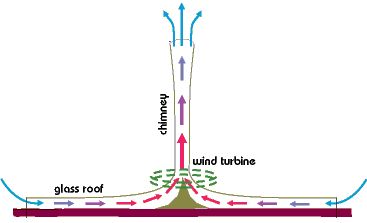Back in 2010, GTM reported on EnviroMission (ASX: EVM; Pink Sheets: EVOMY), an Australia-based company that aims to build a truly massive thermal solar tower. The enterprise still exists and continues to raise capital and issue press releases.
The aspiring project developer just announced that it has "executed a Heads of Agreement with Japanese Funds Manager Valentia" for $110 million that will "take the proposed La Paz Solar Tower development to the project finance stage and provide EnviroMission with development capital for additional projects." The initial $10 million is slated to arrive before the end of September if the deal goes through, according to the company. Valentia is an investment funds manager in Japan with more than $200 billion under management, according to EnviroMission. We have reached out to Valentia for verification and comment.
The "solar tower" is a straightforward idea. A massive tower funnels hot air driven upward by a temperature differential to spin turbines at the base of the tower to create electricity. It's been demonstrated at a small 50-kilowatt scale in Manzanares, Spain. But to make it a reality at utility scale, the tower needs to be 800 meters to 1,000 meters high (as a reference point, the Empire State Building is 373 meters high) and constructed of reinforced concrete or some other durable material. The collector base -- in effect, the real estate around the tower -- needs to be miles in diameter. EnviroMission itself described a proposed project in Australia stretching 1,000 meters high, 130 meters in diameter and with a 5-kilometer diameter collection area.

-
Where Will DOE’s Loan Program Make the Next Climate Tech Investments?
48
-
What the Frack Is Happening With Natural Gas Prices?
15
-
With an Energy Crisis Brewing, No Peak in Sight for Emissions
9
David Gelbaum's Quercus Trust was an investor in 2007, as per this SEC document. In 2011, the firm secured $29.8 million in debt and equity from AGS Capital Group. The company's 2015 financials show early project-development activities in the U.S. Southwest and India, as well as accumulated losses of $39.4 million.
EnviroMission's chief executive, Roger Davey, has claimed that a 200-megawatt unit could be built for $700 million. Davey's annual compensation is $339,603, according to this Reuters data. Christopher James Davey, business development manager, makes $204,445 per year, and Kim Forte, manager of communications, makes $224,603.
The proposed deal with Valentia would provide for another $50 million within nine months and a $50 million investment into the La Paz solar tower development in Arizona "at project company level."
I don't want to dismiss new technologies or big-scale projects, both of which are needed to decarbonize the power sector. Many pink-sheet companies are legitimate. The physics of the project are sound.
But in the U.S., this project would face massive challenges in the permitting process because of environmental and visual impact. The Air Force and the FAA might have issues with the height of the structure. The financing and construction risk are daunting in a first-of-a-kind project like this, and banks don't take kindly to that level of risk.
The CEO suggests that the Valentia investment will allow EnviroMission to commercialize the tower development in Arizona.
Another penny-stock company, Solar Wind Energy Tower (SWET), is selling a similarly scaled downdraft variation of the EnviroMission tower. As Julia Pyper reported, "SWET's technology works by spraying water at the top of a 2,250-foot-high, 500-foot-wide hollow tower, located in a hot, dry climate. As the water saturates the solar-heated air, it evaporates, cools and falls. The air accelerates as it sinks through the tower, creating 50-mile-per-hour winds that exit at the base through a series of tunnels. The rushing winds drive electricity-generating turbines."
Here's a fanciful vision of what EnviroMission has in mind.
